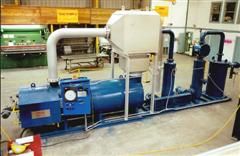
Epcon Catalytic Oxidizers
-Convert process exhaust stream VOCs into harmless amounts of carbon dioxide, water, and thermal energy—which are then safely discharged to the atmosphere
-Use of catalytic oxidizers can result in lower operational costs than thermal oxidation processes
Request a Quote
Availability:
In stock
SKU
EP00400W
Epcon designs systems to accept various selections of catalyst, and with our own internal catalyst expert can assure correct application of our systems to various process exhaust streams. Customers can count on Epcon to design air pollution control systems or any number of custom systems specific to your process.
Epcon Catalytic Oxidizers convert process exhaust stream Volatile Organic Compounds into harmless amounts of carbon dioxide, water, and thermal energy - which are then safely discharged to the atmosphere. This process is known as oxidation. Catalytic Oxidation occurs through a chemical reaction between the VOC hydrocarbon molecules and a precious-metal catalyst bed that is internal to the oxidizer system.
A common misconception is that you've seen one Catalytic Oxidizer, you've seen them all. Or that the same axiom can be applied to industrial ovens. The truth is, the quality of these systems vary greatly.
Certain basics do apply for Catalytic Oxidizers. Catalytic treatment of volatile organic compounds (VOCs) and other air pollutants functions by reacting upon the harmful air pollutants over a customized precious metal catalyst in which VOCs are altered to carbon dioxide, water vapor, and usable heat. Through this catalytic process relatively harmless byproducts are released into the atmosphere or else morph into recovered energy in attempt to lower the costs of operation.
Use of catalytic oxidizers can result in lower operational costs than thermal oxidation processes. In most cases, a control system automatically unlocks the process, energizes the blowers, and purges the system with fresh air prior to igniting the burner and bringing the system up to its optimum operating temperature. Once heated, the air stream laden with VOCs enters the oxidizer's mixing chamber. It's best that a thorough mixing occurs to insure temperature uniformity.



